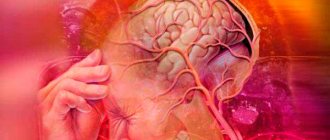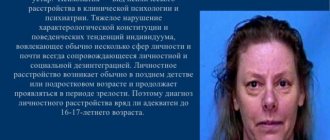What you need to know about this deviation - respiratory neurosis
Respiratory disorder (respiratory neurosis) is a state of mental disorder in a person when he has a serious disturbance in breathing rhythms. This disease can be caused by a variety of circumstances in human life, even the presence of pathology not related to the respiratory system.
Panic shortness of breath may well be a symptom of a mental disorder, but it can also be an independent diagnosis. Doctors apply the following diagnoses to this term: hyperventilation syndrome or dysfunctional breathing.
Doctors conducted research and found that this disease occurs in the majority of patients who suffer from malfunctions of the nervous system. They always showed this symptom – breathing problems. It is complicated by various factors. A respiratory disorder will definitely worsen the functioning of the entire nervous system, the reason for this is panic and suffocation.
The breathing function is associated with the activity of the brain. And failure of breathing and the occurrence of suffocation leads to a failure of the entire functionality of the brain, further aggravating shortness of breath and increasing the degree of fear.
In neurotic people, during an attack, the lungs begin to process more air, trying to saturate the brain with the necessary oxygen. And this creates more oxygen in people’s bloodstream than it needs. At the same time, the percentage of carbon dioxide (CO2) decreases. A low rate of seemingly unnecessary CO2 in the bloodstream will lead to hypocapnia. And hypocapnia is the main cause of exacerbation of respiratory neurosis.
General information about the disease
Respiratory neurosis is a psychological condition of a person in which the correct breathing rhythm is disrupted.
Such a change can be formed on the basis of other psycho-emotional disorders or be an independent illness.
In medicine, this type of neurosis has other names: “dysfunctional breathing” and “hyperventilation syndrome.”
A survey of patients diagnosed with disorders of the nervous system showed that 80% of them experienced a change in their usual breathing rhythm, lack of air, and even suffocation.
This not only creates inconvenience, but also increases anxiety, causes a panic attack and an uncontrollable fear of death, worsening the already precarious emotional state of patients.
The functioning of the human respiratory system is controlled by a special part of the brain.
Failure in the activity of the nervous system, stressful and hysterical conditions cause disruption of this complex mechanism.
The respiratory center of the human brain begins to send too frequent impulses, which reach the diaphragm and muscles along the nerve fibers.
In response to such signals, they begin to contract faster, and more air enters the lungs than occurs normally.
This phenomenon of hyperventilation of the lungs inevitably leads to an imbalance of substances: there is too much oxygen and not enough carbon dioxide in the blood.
A deficiency of the latter is called “hypocapnia” . It is this condition that causes the symptoms of respiratory neurosis.
With respiratory neurosis, attacks of suffocation often occur
Causes of respiratory neurosis in humans
In the mechanism of psychogenic dyspnea, important roles are distributed between psychology and neurology. In some special cases, psychological diseases arise from neurological diseases or vice versa.
Psychosomatic disorders can also ultimately lead to respiratory neurosis. Typically, psychosomatics occurs after exposure to prolonged stress, severe emotional states, and, among other things, can manifest itself due to psychological trauma.
There is another pitfall when shortness of breath appears due to nervousness - the brain itself. The human brain somehow remembers the circumstances under which respiratory neurosis first appeared, and in the future it projects a similar emotional state under similar conditions.
The most possible causes of respiratory rhythm failure:
- psychological or neurological diseases;
- unstable state of mind and emotional background;
- congenital mental pathology;
- prolonged stress;
- disorders of the human nervous system;
- diseases of some respiratory organs;
- exposure to harmful, toxic substances;
- drug overdose;
- innate sensitivity to the percentage of carbon dioxide in the bloodstream.
Treatment methods
Treatment of respiratory neurosis is aimed at eliminating nervous and physical stress, correcting mental disorders, and eliminating mineral imbalances. As part of complex therapy, the patient is taught proper breathing.
Treatment of children during exacerbation of pathology is aimed at eliminating manifestations of anxiety and fear, which is associated with a decrease in the severity of symptoms and improvement in the patient’s well-being. The therapy program includes therapeutic exercises, art therapy (visual creativity), and play therapy.
If severe shortness of breath, convulsive sighs appear against the background of symptoms of neurosis and a panic attack, treatment is reduced to providing emergency assistance to reduce the severity of the manifestations. The patient is asked to breathe inside a paper or plastic bag. The relief of the attack in this case is due to the blocking of the process of respiratory alkalosis.
The patient breathes his exhaled air with a high content of carbon dioxide, which leads to the equalization of the acid-base balance of the blood and the elimination of symptoms. To get rid of the manifestations of pathology, special exercises are done, which is interconnected with the need to regulate such characteristics as the frequency and depth of breaths. Basic principles of breathing exercises:
- Transition to diaphragmatic (involving the abdominal cavity) breathing, which leads to inhibition of the activity of the structures of the reticular pharmacy of the brain stem, responsible for the automatic regulation of inhalation-exhalation cycles. The result is muscle relaxation and mental relaxation.
- Maintaining a certain rhythm - short inhalation and extended exhalation (the duration of exhalation is 2 times longer than the duration of inhalation), reducing the number of inhalation-exhalation cycles (sparse breathing).
- Regularity of classes. The first classes last a few minutes. Gradually the duration of the workout increases. Against the background of regular training, a stable psychophysiological pattern of correct breathing is formed.
Gymnastics is done against a background of positive emotions and the absence of nervous and muscle tension. At the same time, the attending physician prescribes procedures such as autogenic training and psychological correction (psychotherapy). Instrumental treatment includes biofeedback (biological feedback). During the biofeedback procedure, patients develop self-regulation and self-control skills.
Drug therapy
Hyperventilation syndrome correlates with conditions when the patient is very worried or nervous, which confirms the participation of nervous regulation mechanisms (vegetative department) in the pathogenesis. The doctor conducts a diagnosis and, based on the results of the examination, helps the patient to return to a calm life; the main medications prescribed by the psychotherapist have a calming effect.
When correcting anxiety disorders, the first choice drugs are antidepressants, which, according to clinical studies, are more effective than anxiolytics (tranquilizers). Anxiolytics reduce feelings of emotional stress, anxiety, and restlessness. Main drugs: Amitriptyline, Fluvoxamine, Mirtazapine. Psychotropic therapy lasts for about 3-6 months.
In parallel, magnesium and calcium preparations are prescribed. Magnesium deficiency is aggravated as a consequence of stress, which leads to an increase in neuro-reflex excitability and deterioration of cognitive functions. Vitamins of group B are indicated. Drug therapy for pediatric patients involves the prescription of drugs based on plant extracts with a calming effect.
Symptoms of respiratory neurosis
Deviations that relate to breathing problems, even simply due to nervousness, lead to convulsive lack of air, and this is a characteristic sign of the ill-fated respiratory neurosis. At the time of the onset of a nervous attack, the symptoms are standard.
The person is deprived of the ability to breathe evenly, each breath will be convulsive and short, and the patient’s breathing rate becomes increasing. As a result, the patient breathes too shallowly, very quickly, with minimal pauses for exhalation. This leads to a panic attack, where people experience a sudden, uncontrollable level of fear of their own death.
Respiratory neurosis can be acute or chronic. Let's look at these types in more detail:
- Acute respiratory neurosis - people lose control over their breathing rate, panic begins, and loss of consciousness is possible.
- Chronic respiratory neurosis - all symptoms are blurred, characterized by nervous shortness of breath during stressful situations in life. As the disease progresses, the symptoms also worsen.
The presence of respiratory neurosis can manifest itself with a wide variety of symptoms:
- gastroenterological signs ( unpleasant digestive disorders occur , increased gas formation in the intestines, constipation or, conversely, diarrhea, and even stomach pain);
- cardiac (tachycardia, acute pain in the scapula area);
- muscular (muscle weakness, tremors appear);
- neurological (attacks of suffocation, dizziness, fainting, numbness of fingers);
- psycho-emotional (emotional anxiety, insomnia, irritability);
- respiratory (cough, rapid breathing, frequent yawning or lump in throat ).
Respiratory neurosis intensifies over time, the number of symptoms also increases, and the disease worsens. If suffocation began due to nervousness and manifested itself, it will definitely return again. The main thing in the fight against a terrible disease: timely diagnosis and qualified medical treatment.
Causes and symptoms
Breathing failure can occur for various reasons. Often they are of a mixed nature. For example, the following processes can lead to neurosis:
- mental and neurological diseases;
- changes in psycho-emotional state;
- frequent stress;
- dysfunction of the autonomic nervous system;
- diseases of the respiratory system;
- influence of toxic substances;
- overdose of medications.
The attack of hyperventilation can be repeated under the same circumstances. This is due to the fact that the brain remembers the situation in which a person first felt shortness of breath and lack of oxygen. For example, if this happened in the subway, then during subsequent descents underground a pathological condition may be regularly observed.
Dysfunctional breathing can have 2 forms: acute or chronic. During an attack, a person cannot breathe evenly. He takes frequent short breaths, which are also characterized by intermittency. Then there is a short stop, after which the patient again begins to convulsively swallow air.
In the acute form, a person falls into a hysterical state and is overcome by fear that he will die from suffocation.
In the chronic course of the disease, the patient is bothered by shortness of breath, which occurs in situations when he experiences excitement. As the disease progresses, it begins to manifest itself in a large number of symptoms. The most common are increased body temperature and frequent dizziness. Pathology in the form of hyperventilation affects all functions of the body and can manifest itself in the following:
- The functioning of the digestive organs is disrupted. Excessive gas, constipation, or indigestion occurs. Pain may be felt in the stomach or intestines. Appetite decreases, dry mouth appears.
- The heart rate accelerates. Pain is felt in the lungs. Pain may occur in the area of the left shoulder blade.
- Weakness appears in the muscles. Trembling of the limbs may occur.
- The appearance of goosebumps on the skin, numbness of the limbs.
- Irritability, insomnia.
- Cough, yawning, spasms when breathing. There may be a feeling of a lump in the throat.
Some, due to the characteristics of the body, have a predisposition to the state of this type of neurosis. Their body is highly sensitive to the level of carbon dioxide in the blood. As a result of its decrease, dizziness occurs and loss of consciousness may occur.
If hyperventilation syndrome is not treated, its attacks will begin to appear more often, and the symptoms will be more intense.
Childhood respiratory neurosis
In children of all ages, acute respiratory neurosis is sometimes also diagnosed, and a thorough examination is required. This can become a symptom of various mental illnesses and disorders of the child’s entire nervous system.
Children's respiratory neurosis is a consequence of stress and mental trauma. With an exacerbation of childhood neurosis, sharp and frequent changes in his mood may be observed, accompanied by prolonged hysterics.
A striking symptom is a sharp change in the child’s usual lifestyle that is contrary to the entire environment. This could be, for example, a break in relationships with best friends or girlfriends. This condition can be expressed in the destruction of favorite toys, which until this moment were carefully stored.
The child sleeps poorly and suffers from painful insomnia. There are frequent attacks of convulsive breathing and suffocation, lack of air. All this leads to even greater nervousness.
Treatment
The course of therapy is prescribed in each case individually. But most often, several techniques are used at once to cope with the psycho-emotional state and keep breathing under control.
Medication
Medicines for respiratory neurosis are prescribed only in severe cases. The following drugs are effective:
- Sedatives. Eliminate anxiety, help normalize sleep and increase stress resistance. But often they are used during the rehabilitation period and allow the patient to return to normal life. They are considered to have a mild calming effect.
- Tranquilizers and antidepressants. Used to relieve depression, aggression and anxiety. Prescribed when patients with respiratory neurosis experience attacks of panic attacks and disturbances in their psycho-emotional state.
- Neuroleptics. The active substances of the drugs block certain brain structures. They are taken only in a course, the duration of which is determined by the doctor. Combined with sedatives.
- Vitamin complexes. Aimed at strengthening immunity weakened by stress. It is a stressful state that causes frequent colds and the development of more serious diseases. All of them, as a result of insufficient work of the body’s defenses, are difficult and with complications.
When prescribing medications for respiratory neurosis, the specialist takes into account individual sensitivity to active substances and the presence of contraindications.
Psychotherapy
Respiratory neurosis occurs for certain reasons that should be established. For this, patients need the help of a psychotherapist. Treatment occurs in several stages:
- awareness of the problem;
- rethinking;
- understanding fear;
- acquiring a new perspective on ordinary things.
The final stage of therapy for respiratory neurosis is training to neutralize the anxiety state. Each of these stages has specific goals and is mandatory. Treatment with a psychotherapist sometimes takes a long time, especially in severe cases, when the disease is accompanied by pronounced symptoms, for example, fainting.
You should not ignore the advice and recommendations of a psychotherapist, as the specialist does everything possible to help the patient cope with such a condition.
Breathing exercises
Specially designed exercises help cope with anxiety and relax the respiratory muscles. At the initial stages, the patient undergoes the procedure with a specialist. Then he makes them himself.
Gymnastics in cases where respiratory neurosis is established contributes to a significant improvement in the general condition and can be used for anxiety attacks and panic attacks.
Diagnosis: “respiratory neurosis”
It is incredibly difficult to identify a disease such as respiratory neurosis. When breathing problems occur due to nervousness, they are often confused with signs of many other serious diseases:
- hyperventilation syndrome;
- cardiovascular diseases;
- insomnia;
- gastroenterological diseases.
To make a correct diagnosis of respiratory neurosis, doctors have to act blindly, by excluding other diseases. Capnography helps diagnose pathology. This test measures CO2 levels during an artificially induced bout of rapid breathing.
A conversation with a doctor, where the patient answers honestly even to not very pleasant questions, also helps to establish an accurate diagnosis. The patient should tell in more detail about the nature of the complaints, how pronounced the symptoms are and the frequency of recurrence of attacks.
Dutch pulmonologists have created a special test that consists of 16 questions regarding hyperventilation. The patient, answering the questions, evaluates the degree and intensity of each statement in relation to himself. This allows the doctor to correctly diagnose and determine the severity of the disease.
Diagnostics
Making a diagnosis of “respiratory neurosis” is not an easy task.
The symptoms of this condition are often disguised as other diseases with which hyperventilation syndrome must be differentiated.
For example, with pain in the center of the chest, it is important to exclude cardiac pathologies.
Therefore, when diagnosing respiratory neurosis, doctors often act by exclusion. This may require more than one examination.
If you have special diagnostic equipment, it would be useful to perform capnography.
This test measures the concentration of carbon dioxide that a person exhales.
The patient is asked to breathe more often, thereby simulating an attack of respiratory neurosis.
This allows the carbon dioxide levels to be recorded during episodes of hyperventilation.
A conversation with the patient will be of great benefit to the doctor in making a correct diagnosis: discussing the nature of the complaints, the degree of their severity and the rate of progression.
The Nijmigen Questionnaire , a special test developed by pulmonologists from Holland, can be used.
It consists of 16 items , each of which represents a sign of hyperventilation. The patient must evaluate their severity in points from 0 to 4. This allows you to collect and systematize important information about the person’s health status.
Diagnosis of respiratory neurosis
The diagnosis of hyperventilation syndrome is made only after consultation with a neurologist. This is explained by the fact that the symptoms of respiratory neurosis are characteristic of many diseases of the internal organs. The diagnosis is made by excluding other pathologies with a similar clinical picture.
consultation with a neurologist
If neurosis is suspected, it is necessary to evaluate the level of carbon dioxide concentration (capnography). The method is based on assessing the percentage of oxygen and carbon dioxide in the air exhaled by the patient. The study is carried out using specialized and rather rare equipment. If cerebral hypoxia is detected, capnography is considered the main method for diagnosing hyperventilation syndrome.
A blood test is performed for a similar purpose. During the study, the concentration levels of oxygen and carbon dioxide are assessed and compared with normal values.
In order to differentiate neurosis from other diseases, spirometry is prescribed. The method allows you to evaluate how the lungs expand when inhaled and determine the nature of the passage of air through the respiratory tract.










